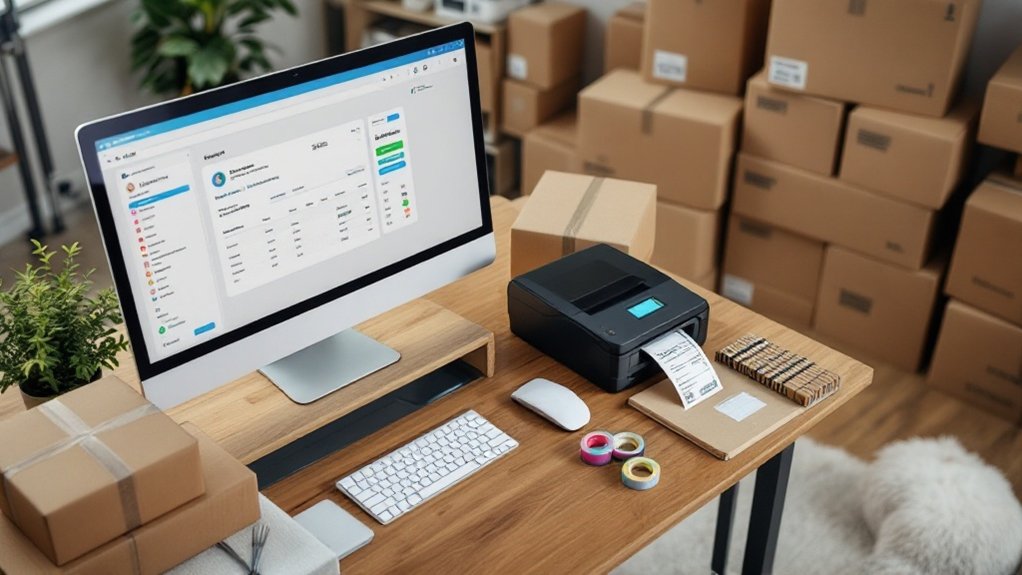Modern shipping software helps small businesses automate their shipping operations while reducing costs. These systems integrate with e-commerce platforms, enable automated label creation, and provide real-time tracking capabilities. Key features include multi-carrier rate comparison, batch processing, and detailed analytics. With setup costs ranging from $500-$5000, businesses typically see ROI of 200-400% within the first year through labor savings and improved customer satisfaction. Understanding the complete feature set reveals even more potential benefits for growing businesses.
Quick Overview
- Shipping software automates label creation, rate comparison, and tracking while integrating with major carriers to streamline small business logistics operations.
- Modern platforms offer integration with 300+ e-commerce systems, enabling seamless order management across multiple sales channels.
- Businesses typically see 200-400% ROI within the first year, with labor savings of 30-50% and reduced shipping errors.
- Real-time tracking and automated customer notifications improve satisfaction rates and reduce support inquiries about shipment status.
- Features like batch processing and automated carrier selection save time while optimizing shipping costs for better profitability.
Understanding the Essentials of Shipping Software

Modern shipping software serves as the backbone of successful small business logistics operations. At its core, this essential technology combines several key components that streamline the shipping process from start to finish.
The fundamental elements include seamless order management integration, automated label creation, and real-time tracking capabilities. These features work together to create a thorough solution that helps businesses manage their shipping operations efficiently. Small businesses can leverage batch shipping options to process multiple orders simultaneously and save valuable time.
The software typically connects with multiple carriers, allowing companies to compare rates instantly and select the most cost-effective options.
For peak performance, shipping software must integrate smoothly with existing e-commerce platforms through API connectivity. A user-friendly interface guarantees quick adoption by staff, while mobile accessibility enables management of shipping operations from anywhere.
Regular updates keep the system current with industry standards and carrier requirements.
Top Features That Drive Business Growth
While every business endeavors for growth, the right shipping software features can dramatically accelerate that expansion. The most impactful features focus on three key areas: automation, integration, and scalability.
Automation tools eliminate up to 70% of processing time through automatic data entry, order importing, and rate shopping. These systems handle batch processing efficiently while providing real-time tracking updates to customers. Enhanced security features ensure data encryption protects sensitive business information.
Integration capabilities connect seamlessly with over 300 e-commerce platforms, allowing businesses to manage orders across multiple sales channels. The software’s scalability guarantees smooth operation during seasonal peaks and supports expansion into new markets.
Additionally, robust analytics tools provide valuable insights into shipping trends and costs, enabling data-driven decisions.
These features work together to enhance customer experience through simplified returns, customizable tracking, and reliable delivery estimates.
Cost-Benefit Analysis and ROI

Investment decisions in shipping software require careful evaluation of both immediate costs and long-term returns. The data shows that while initial setup costs range from $500-$5000, businesses typically achieve ROI of 200-400% within the first year, with break-even points reached in 3-6 months. Real-time shipping rates from multiple carriers help businesses optimize their shipping expenses significantly.
| Cost Factor | Benefit Impact |
|---|---|
| Setup: $500-$5000 | Labor savings: 30-50% |
| Monthly fees: $25-$500 | Error reduction: 5-10% |
| Training: 2-5 days | Delivery speed: 1-2 days faster |
| Integration: 1-4 weeks | Customer retention: 10-20% up |
The financial benefits extend beyond direct cost savings. Businesses report significant improvements in operational efficiency, with automated workflows reducing shipping task time by 50-75%. Additionally, enhanced customer experience through real-time tracking and faster deliveries contributes to increased customer retention rates.
Key Integration Requirements for Success
Successful shipping software implementation depends heavily on seamless integration across multiple business systems and carriers. For small businesses, five key integration points are essential:
- Carrier connections that enable real-time rate comparison and automated selection among major shipping providers like UPS, USPS, and FedEx.
- E-commerce platform compatibility, ensuring smooth data flow with systems like Shopify and WooCommerce.
- Order management integration for automated status updates and batch processing.
- Warehouse management connectivity to sync inventory and streamline fulfillment processes.
- Analytics integration for thorough reporting and KPI tracking.
These integrations create a unified ecosystem where shipping data flows automatically between systems, reducing manual work and errors. With the logistics API market projected to reach USD 12.9 billion by 2030, small businesses are increasingly recognizing the value of comprehensive shipping software solutions.
Small businesses should prioritize software solutions that offer these core connections while maintaining flexibility for future growth.
Security and Data Protection Measures

Security stands at the forefront of any effective shipping software implementation.
Modern shipping solutions must incorporate robust protection measures to safeguard sensitive business and customer data. With 60% of small businesses failing within six months of a security breach, implementing comprehensive safeguards is crucial for long-term survival. A thorough security framework includes multiple layers of protection, from encryption to access control. Solutions like end-to-end encryption have become essential for protecting sensitive shipping data while maintaining compliance with industry regulations.
Effective shipping systems require comprehensive security protocols to protect critical data through layered safeguards and controlled access.
Essential security measures for shipping software include:
- Data encryption using AES256-GCM for sensitive information both in transit and at rest
- Multi-factor authentication and principle of least privilege to control user access
- Secure network protocols including HTTPS for safe data transmission
- Regular security audits and compliance monitoring to maintain industry standards
These protective measures guarantee that shipping operations remain secure while meeting regulatory requirements.
Optimizing International Shipping Operations
Every international shipping operation demands careful orchestration of multiple moving parts to function efficiently. Small businesses can streamline their global shipping processes by implementing automated customs documentation systems and optimizing packaging strategies. Bulk shipping rates help reduce overall operational costs while maintaining service quality.
Key improvements include:
- Using automated form generation with HS codes for faster customs clearance
- Implementing dimensional weight pricing and eco-friendly packaging solutions
- Providing real-time tracking with GPS integration and predictive ETAs
- Utilizing data analytics for route optimization and carrier selection
- Streamlining returns management with automated label generation
Modern shipping software helps businesses integrate these features seamlessly while maintaining compliance with international regulations.
Route optimization algorithms analyze historical data to identify efficient paths, while automated tracking systems keep customers informed throughout the shipping journey.
This systematic approach reduces costs, minimizes delays, and enhances the overall shipping experience.
Frequently Asked Questions
Can I Switch Carriers Without Disrupting My Existing Shipping Operations?
Gone are the days when switching carriers meant shipping chaos. Modern businesses can seamlessly shift between carriers through proper planning and technology.
While some operational adjustments are needed, disruption can be minimized by implementing a phased approach, utilizing shipping software with multi-carrier support, and training staff gradually.
Most companies report successful carrier changes by starting with small volume tests before full implementation. The key is maintaining existing operations while slowly integrating new carriers.
How Long Does It Take to Train Staff on New Shipping Software?
Training staff on new shipping software typically takes 1-2 days for basic operations, while full proficiency develops within 1-2 weeks.
Tech-savvy employees often learn faster, while those with prior shipping experience can adapt more quickly.
Factors affecting training duration include:
- Software complexity
- Individual learning pace
- Available training resources
- Depth of features needed
Most companies find success with a combination of video tutorials, hands-on practice, and peer mentoring to accelerate the learning process.
What Happens to My Shipping Data if I Cancel My Subscription?
“What’s done is done” isn’t always true with shipping data. When cancelling a subscription, account information is typically retained for a limited period, allowing potential reactivation.
While immediate access to shipping history usually ends upon cancellation, some providers offer data export options beforehand.
Historical records may remain available briefly post-cancellation, though access to past invoices becomes restricted.
In-transit shipment tracking usually stays accessible until delivery completion.
Do Shipping Software Platforms Work With Custom-Sized Packages and Labels?
Most shipping software platforms fully support custom-sized packages and labels.
These systems typically offer:
- Built-in dimensional weight calculators
- Flexible label customization options
- Support for non-standard shapes and sizes
- Integration with various printer types
Users can manually input custom dimensions or use digital measurement tools for accuracy.
The software automatically adjusts shipping rates based on package specifications and works seamlessly with major carriers like USPS, UPS, and FedEx.
Can Multiple Users Access the Shipping Software Simultaneously From Different Locations?
Modern shipping software platforms are designed for multi-user access, allowing team members to work simultaneously from different locations.
Users can log in securely through cloud-based systems, with each person having unique credentials and permissions based on their role.
Real-time updates guarantee all users see the latest shipping information, while role-based access controls maintain data security.
This functionality enables seamless collaboration across warehouses, offices, and remote workstations.
Conclusion
Small business shipping software has become essential for modern commerce success. Take Sarah’s Handmade Soaps, which grew from 10 local deliveries to 200 international shipments weekly after implementing integrated shipping solutions. By choosing the right software with robust features, security measures, and seamless integrations, small businesses can streamline operations, reduce costs, and scale efficiently. Smart shipping technology isn’t just a convenience—it’s a competitive necessity in today’s digital marketplace.








